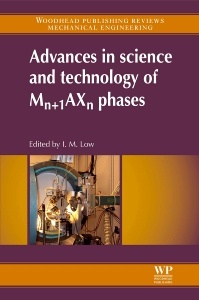Advances in Science and Technology of Mn+1AXn Phases

List of figures
List of Tables
Preface
About the editor and contributors
Chapter 1: Methods of MAX-phase synthesis and densification – I
Abstract:
1.1 Introduction
1.2 Synthesis methods
Chapter 2: Methods of MAX-phase synthesis and densification – II
Abstract:
2.1 Introduction
2.2 Powder synthesis
2.3 Synthesis of solids
2.4 Synthesis of thin films
2.5 Mechanisms of reaction synthesis for MAX phases
2.6 Conclusions
Chapter 3: Consolidation and synthesis of MAX phases by Spark Plasma Sintering (SPS): a review
Abstract:
3.1 Introduction
3.2 Spark plasma sintering
3.3 Spark plasma sintering of MAX phases
3.4 MAX phase composites
3.5 MAX phase solid solutions
3.6 MAX phase coatings
3.7 Conclusions
Chapter 4: Microstructural examination during the formation of Ti3AlC2 from mixtures of Ti/Al/C and Ti/Al/TiC
Abstract:
4.1 Introduction
4.2 Experimental procedure
4.3 Effect of starting powder mixtures on formation of Ti3AlC2
4.4 Reaction routes for powder mixture of 3Ti/Al/2C
4.5 Reaction routes for powder mixture of Ti/Al/2TiC
4.6 Summary
Chapter 5: Fabrication of in situ Ti2AlN/TiAl composites and their mechanical, friction and wear properties
Abstract:
5.1 Introduction
5.2 Fabrication of Ti2AlN/TiAl composites
5.3 Mechanical properties of Ti2AlN/TiAl composites
5.4 Friction and wear properties of Ti2AlN/TiAl composites at room temperature
5.5 Friction and wear properties of Ti2AlN/TiAl composites at high temperature
5.6 Conclusions
Chapter 6: Use of MAX particles to improve the toughness of brittle ceramics
Abstract:
6.1 Introduction
6.2 Experimental
6.3 Results and discussion
6.4 Conclusions
Chapter 7: Electrical properties of MAX phases
Abstract:
7.1 Introduction
7.2 Resistivity
7.3 Conduction mechanisms
7.4 Superconductivity
7.5 Conclusions
Acknowledgement
Chapter 8: Theoretical study of physical properties and oxygen incorporation effect in nanolaminated ternary carbides 211-MAX phases
Abstract:
8.1 Introduction
8.2 Crystal structure of MAX phases
8.3 Steric effect on the M-site in MAX phases
8.4 Bulk modulus of MAX phases
8.5 Analysis of the electronic structure
8.6 Elastic properties
8.7 Effect of oxygen incorporation on the structural, elastic and electronic properties in Ti2SnC
8.8 Conclusions
Note
Chapter 9: Computational modelling and ab initio calculations in MAX phases – I
Abstract:
9.1 Introduction
9.2 Density functional theory
9.3 The structural properties of Mn + 1AXn under pressure
9.4 Ab initio study of electronic properties
9.5 Ab initio study of mechanical properties
9.6 Ab initio study of optical properties
Chapter 10: Computational modeling and ab initio calculations in MAX phases – II
Abstract:
10.1 Computational modeling of MAX phases
10.2 Electronic structures and properties of MAX phases
10.3 Stabilities and occurrences of MAX phases
10.4 Elasticity and other physical properties of MAX phases
10.5 Effects of defects and impurities in MAX phases
10.6 Summary
Chapter 11: Self-healing of MAX phase ceramics for high temperature applications: evidence from Ti3AlC2
Abstract:
11.1 Introduction
11.2 Evidence of crack healing
11.3 Oxidation of crack surfaces
11.4 Mechanical properties of healed Ti3AlC2 ceramics
11.5 Crack healing mechanism
11.6 Conclusions and future perspectives
Acknowledgements
Chapter 12: Oxidation characteristics of Ti3AlC2, Ti3SiC2 and Ti2AlC
Abstract:
12.1 Introduction
12.2 Experimental procedures
12.3 Results and discussion
12.4 Conclusions
Acknowledgements
Chapter 13: Hydrothermal oxidation of Ti3SiC2
Abstract:
13.1 Introduction
13.2 Hydrothermal oxidation of Ti3SiC2 powders
13.3 Effect of Al dopant on the hydrothermal oxidation of Ti3SiC2 powders
13.4 Hydrothermal oxidation of bulk Ti3SiC2
13.5 Summary
Chapter 14: Stability of Ti3SiC2 under charged particle irradiation
Abstract:
14.1 Introduction
14.2 Effect of ion irradiation in carbides
14.3 Lattice parameter and microstrains
14.4 Disorder and amorphisation
14.5 Phase transformations
14.6 Damage tolerance
14.7 Defect annealing
14.8 Conclusions
Acknowledgements
Chapter 15: Phase and thermal stability in Ti3SiC2 and Ti3SiC2/TiC/TiSi2 systems
Abstract:
15.1 Introduction
15.2 Experimental methods
15.3 Results and discussion
15.4 Conclusions
Acknowledgements
Index
- The most up-to-date and comprehensive research data on MAX phases is presented
- Written by highly knowledgeable and well-respected researchers in the field
- Discusses new and unusual properties
Date de parution : 10-2012
Ouvrage de 474 p.
15.5x23.2 cm



